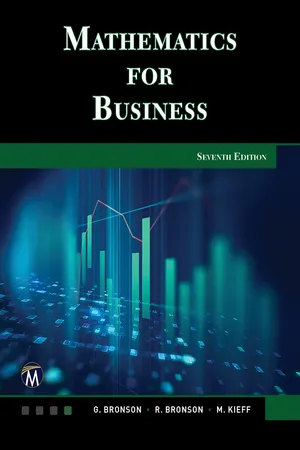Mathematics
Quadratic Graphs
Quadratic graphs are a type of graph that represents a quadratic function, which is a second-degree polynomial equation. These graphs form a parabola, a U-shaped curve, and can be used to model various real-world phenomena. They are characterized by a specific equation in the form y = ax^2 + bx + c, where a, b, and c are constants.
Written by Perlego with AI-assistance
Related key terms
7 Key excerpts on "Quadratic Graphs"
- eBook - ePub
Differentiating Instruction in Algebra 1
Ready-to-Use Activities for All Students (Grades 7-10)
- Kelli Jurek(Author)
- 2021(Publication Date)
- Routledge(Publisher)
Unit Objectives As a result of this unit, students will know:- ➤ quadratic functions have an independent variable raised to a second power,
- ➤ when quadratic functions are graphed they are shaped like parabolas, and
- ➤ all quadratic functions have a vertex, a line or symmetry, and a minimum or maximum.
- ➤ quadratic functions can be written in three different forms, and each form provides key information about the quadratic;
- ➤ quadratic functions can have zero, one, or two solutions;
- ➤ quadratic functions can be solved using various methods; and
- ➤ quadratic functions model real-life situations.
- ➤ identify a quadratic relationship from a graph, table, or equation;
- ➤ find the vertex, axis of symmetry, and roots (zeros) from a graph, table, or equation;
- ➤ solve quadratic equations by graphing, factoring, completing the square, or using the quadratic formula; and
- ➤ interpret maximum and minimum points and intercepts in real-life applications.
Launch Scenarios
- ➤ After a soccer game, teammates shake hands to congratulate each other. How many handshakes are exchanged between a team with seven players? A team of nine players? A team of 11 players? (Lesson 2)
- ➤ You are putting a fence in your backyard to surround your garden, but you are limited to 24 meters of fencing. How should you arrange the fencing in order to maximize the amount of garden space? (Lesson 2)
- ➤ You want to put a decorative stone walking path along two adjacent sides of a water garden. The water garden measures 4 ft by 10 ft. How wide should the path be if there is enough decorative stone to cover 51 square feet? (Lesson 4)
- ➤ You are building a catapult to launch objects in your algebra class. How many feet away from the landing site do you have to place your catapult in order to hit the target? (Lesson 6)
- eBook - ePub
- Gary Bronson, Richard Bronson, Maureen Kieff(Authors)
- 2021(Publication Date)
- Mercury Learning and Information(Publisher)
2GRAPHS AND LINEAR EQUATIONSIn this Chapter2.1 The Cartesian Coordinate System2.2 Line Graphs2.3 Graphing Linear Equations2.4 Properties of Straight Lines2.5 Break-Even Analysis2.6 Constructing Line Graphs using Excel2.7 Summary of Key PointsGraphs have a visual impact and are a powerful medium for presenting data, and relationships, just as pictures do for words. They are used by the Census Bureau to display national statistics, by newspapers to show trends, and by social scientists to demonstrate correlations between social behaviors. Corporations use graphs to illustrate growth, and speakers routinely use graphs to support their conclusions. Graphs cut across all disciplines as the most widely used model for displaying real-world behavior.Equations are a convenient and concise way of representing relationships between quantities, such as sales and advertising, profit and time, cost and number of units manufactured, and so on. As such, they are used to “model” or represent real-world situations. Although an equation usually does not reveal all the relationships between the quantities under investigation, they often contain enough information for one to make meaningful observations and practical decisions.2.1 THE CARTESIAN COORDINATE SYSTEMA graph is a diagram that represents data in an organized manner. Bar graphs, column graphs, line graphs, and pie charts, as shown in Figures 2.1 through 2.3 , respectively, illustrate these types of graphs.1 - eBook - ePub
- John Bird(Author)
- 2017(Publication Date)
- Routledge(Publisher)
When a mathematical equation is known, co-ordinates may be calculated for a limited range of values, and the equation may be represented pictorially as a graph, within this range of calculated values. Sometimes it is useful to show all the characteristic features of an equation, and in this case a sketch depicting the equation can be drawn, in which all the important features are shown, but the accurate plotting of points is less important. This technique is called ‘curve sketching’ and can involve the use of differential calculus, with, for example, calculations involving turning points.If, say, y depends on, say, x , then y is said to be a function of x and the relationship is expressed as y = f (x ); x is called the independent variable and y is the dependent variable.In engineering and science, corresponding values are obtained as a result of tests or experiments. Here is abrief resume of standard curves, some of which have been met earlier in this text. (i) Straight lineThe general equation of a straight line is y = mx + c , where m is the gradient(and c is the y -axis intercept.i .e .)d yd xTwo examples are shown in Fig. 20.1Figure 20.1(ii) Quadratic GraphsThe general equation of a quadratic graph is y = ax 2 + bx + c , and its shape is that of a parabola. The simplest example of a quadratic graph, y = x 2 , is shown in Fig. 20.2 .Figure 20.2(iii) Cubic equationsThe general equation of a cubic graph is y = ax 3 + bx 2 + cx + d .The simplest example of a cubic graph, y = x 3 , is shown in Fig. 20.3 .Figure 20.3(iv) Trigonometric functions (see Chapter 15 , page 162)Graphs of y = sin θ , y = cos θ and y = tan θ are shown in Fig. 20.4 .Figure 20.4(v) Circle (see Chapter 14 , page 155)The simplest equation of a circle is x 2 + y 2 = r 2 , with centre at the origin and radius r , as shown in Fig. 20.5 .Figure 20.5More generally, the equation of a circle, centre (a, b ), radius r , is given by:+(2x − a)=(2y − b)r 2Figure 20.6 shows a circle+(2x − 2)= 4(2y − 3)Figure 20.6(vi) Ellipse The equation of an ellipse is+x 2a 2= 1y 2b 2and the general shape is as shown in Fig. 20.7 - eBook - ePub
Making Sense of Mathematics for Teaching High School
Understanding How to Use Functions
- Edward C. Nolan, Juli K. Dixon, Farhsid Safi, Erhan Selcuk Haciomeroglu(Authors)
- 2016(Publication Date)
- Solution Tree Press(Publisher)
x = 3.One advantage of using the standard form of a line is that any line in the Cartesian coordinate plane—including vertical lines—can be described by this form. Through exploration, students come to see the benefits of certain forms of equations of a line over others. At times, the format is determined by the givens in the problem, and at other times, the format is driven by the goals of the problem. The same is true for quadratic equations.Exploring Different Forms of Quadratic FunctionsBy definition, a quadratic function is a function that can be described as f(x) = ax2 + bx + c, where a, b, and c are real numbers and a is not equal to zero. This form of the quadratic function is commonly referred to as the standard form. It is helpful for students to explore the constraint on the value of a being nonzero to determine the form of a quadratic function if the value of a is zero. As you may have realized, the function will be a linear function if the value of the parameter a in the standard form of a quadratic function is zero.Students explore quadratic functions in several forms. Why is this useful? Consider the task provided in figure 2.10 explore additional forms of the quadratic function.Figure 2.10: Model using different forms of a quadratic function task.While both functions model the path of the water in this fountain, which mathematical form is more suitable to answer the questions posed in this task? Which function, f(x) = −(x − 5)2 + 25 or f(x) = −x2 + 10x, allows you to more efficiently identify the vertex based on its structure? From the graph, you see that the maximum value occurs at (5, 25). In examining the two different representations of the quadratic function given in the task, you see that 5 and 25 both appear in the first equation. In this task, the value (5, 25) can be identified as the vertex (h, k) yielding the highest point on this curve. This equation is the vertex form of the quadratic equation, represented by y = a(x − h)2 + k. The values for h and k identify the vertex, but why? It is helpful to provide students opportunities to see that this form of the quadratic function always identifies the extreme value—maximum or minimum—of a quadratic function. This can be accomplished by engaging students in Mathematical Practice 8, “Look for and express regularity in repeated reasoning,” by providing several graphs of functions along with the vertex form of the equation for students to examine. Once students are able to conjecture that the vertex is identified within the vertex form by (h, k), they can be supported to engage in Mathematical Practice 7, “Look for and make use of structure,” to determine why this is the case. If given the opportunity, they can see that (x − h)2 cannot be negative and the minimum value for (x − h)2 occurs when x − h = 0. That minimum value describes the turning point of the graph, and at that minimum value, k describes the value for y because when x − h = 0, the function becomes y = k. An interesting question to ask students is how this minimum value can also describe the maximum point of the function, as with the case in the task in figure 2.10 . Students come to see the importance of the value of the parameter a - eBook - ePub
- Michael Harrison, Patrick Waldron(Authors)
- 2011(Publication Date)
- Routledge(Publisher)
Conic sections, quadratic forms and definite matrices
DOI: 10.4324/9780203829998-6 f4.1 Introduction
So far, we have concentrated on linear equations, which represent lines in the plane, planes in three-dimensional space or, as will be seen in Section 7.4.1 , hyperplanes in higher dimensions. In this chapter, we consider equations that also include second-order or squared terms, and that represent the simplest types of nonlinear curves and surfaces.The concepts of matrix quadratic form and definite matrix are of considerable importance in economics and finance, as will be seen in the detailed study of our several applied examples later. Quadratic forms relate importantly to the algebraic representation of conic sections. Also, in Theorem 10.2.5, it will be seen that the definiteness of a matrix is an essential idea in the theory of convex functions. This chapter gives definitions and simple illustrations of the concepts of quadratic form and definiteness before going on to establish a number of theorems relating to them. We will return to quadratic forms in Chapter 14 , where the important general problem of maximization or minimization of a quadratic form subject to linear inequality constraints is studied.4.2 Conic sections
In this section, we consider equations representing conic sections in two dimensions. There are a number of equivalent ways of describing and classifying conic sections. We begin with a geometric approach.1Consider the curve traced out in the coordinate plane ℝ2 by a point P = (x, y), which moves so that its distance from a fixed point (the focus S ) is always in a constant ratio (the eccentricity ϵ ≥ 0) to its perpendicular distance from a fixed straight line (the directrix L). This curve is called:- an ellipse when 0 < ϵ < 1;
- a parabola when ϵ = 1;
- a hyperbola when ϵ > 1; and
- a circle as ϵ → 0, as we shall see later.
4.2.1 Parabola
Consider first the case of ϵ = 1, i.e. the parabola. The equation of the parabola takes its simplest form when the focus S is a point on the positive x axis, say (a, 0), where a > 0, and the directrix is the vertical line with equation x = −a. An example of a parabola is shown in Figure 4.1 - eBook - ePub
- P.M. Cohn(Author)
- 2017(Publication Date)
- Chapman and Hall/CRC(Publisher)
9 Applications I. Algebra and geometry In this chapter and the next we give some illustrations of how the methods developed in Chapter 1, Chapter 8 can be applied. In most cases we merely sketch the outlines, to whet the reader’s appetite, with a reference to more thorough treatments. 9.1 QUADRICS IN SPACE A quadric surface or simply quadric is a surface in 3-space given by an equation of the second degree in the coordinates. It will be convenient to express all vectors in terms of coordinates referred to a right-handed rectangular coordinate system in space. Instead of speaking of ‘the vector whose components are a 1, a 2, a 3 ’ we shall simply speak of ‘the vector (a 1, a 2, a 3)’, leaving the coordinate system to be understood. As before, we shall abbreviate the coordinates by a single letter, for example, to say that u is a unit vector is to say that its components u 1, u 2, u 3 satisfy u 1 2 + u 2 2 + u 3 2 = 1, or, in matrix notation, u T u = 1, where u T = (u 1, u 2, u 3) and u is the corresponding column. The most general equation of the second degree (in 3-space). is a 11 x 1 2 + a 22 x 2 2 + a 33 x 3 2 + 2 a 12 x 1 x 2 + 2 a 13 x 1 x 3 + 2 a 23 x 2 x 3 + 2 a 1 x 1 + 2 a 2 x 2 + 2 a 3 x 3 + α = 0 where a 11,…, a 3, α are real numbers. In matrix form this equation can be written as x T A x + 2 a T x + α = 0 (9.1) where A = (a ij) is a symmetric matrix and a T = (a 1, a 2, a 3). A complete description of quadrics would take us too far afield, so we shall limit ourselves to the case where the matrix A is regular. In that case the quadric (9.1) is called central, because such a quadric has a centre of symmetry. This centre may be determined as follows. If we make a parallel translation of our coordinate system by a vector b, then the point with position vector x is described by a vector y, related to x by the equation x = y + b Expressed in the new system, equation (9.1) becomes y T A y + y T A b + b T A y + 2 a T y + β = 0 where β = b T Ab + 2 a T b + α - eBook - ePub
- Paul Turner, Justine Wood(Authors)
- 2023(Publication Date)
- Mercury Learning and Information(Publisher)
x -axis than the original curve.FIGURE 2.3 Parabolas with parameters 1 (solid line) and 2 (broken line).REVIEW EXERCISES – SECTION 2.11. Calculate the equations of the straight lines passing through the following pairs of coordinates.(a)(b)(c)2. Given the following equations for straight lines, calculate the values of x, which give(a)(b)(c)3. Variables x and y both vary with time according to the formulas and . This defines a curve in the Cartesian plane. Find the alternative representation in the form of an equation which links y and x .2.2 FUNCTIONSA function is a rule which takes an element from one set and maps it to the elements of another set. Although functions are often written in the form of equations, they are not the same thing.A function is a rule which associates objects in one set with objects in another set. For example, a function could be a rule which takes one number (the argument or input ) and uses it to assign another number (the output or result ). Equations are often used to define the rule, but simply writing down an equation relating two variables is not sufficient to define a function. To fully define a function, we must also specify the sets of numbers which are valid inputs and outputs of the relationship we define. A simple example is an equation of the form . For this to be a function, we must also specify the set of numbers from which x is drawn and the set of numbers that comprises the possible outcomes, y . These are referred to as the domain and the codomain of the function. For example, we can define a function using the relationships shown in (2.1):. (2.1)The first part of the definition consists of the equation . This defines the rule which takes x, the argument of the function, and maps it to y , the output . The second part of this function defines the domain and the codomain. In this example, we say that the function f “maps” the set of integers to the set of integers. The notation can be read as “f maps the set of integers to itself.” Note that the same equation could be used to map the set of real numbers to itself, that is,
Index pages curate the most relevant extracts from our library of academic textbooks. They’ve been created using an in-house natural language model (NLM), each adding context and meaning to key research topics.






